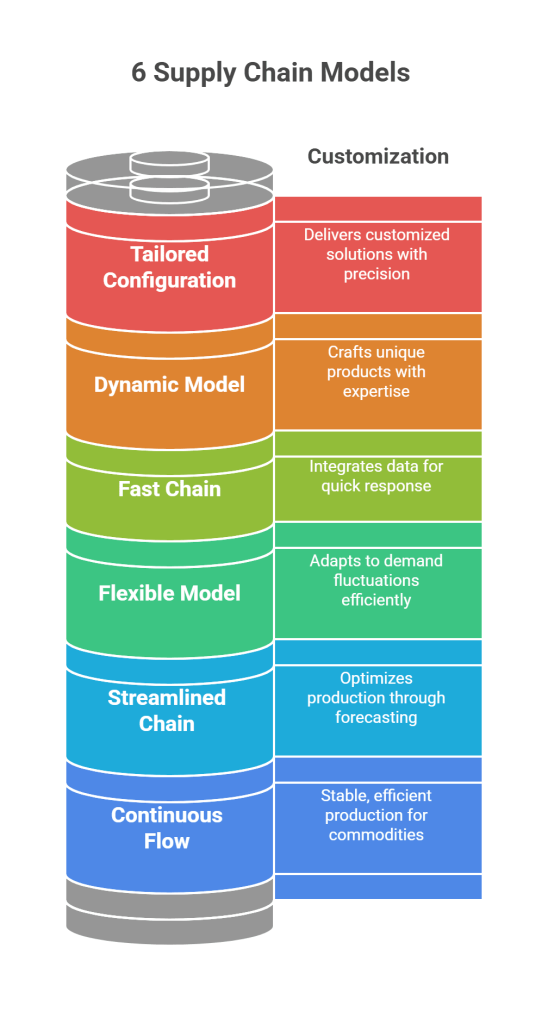
A supply chain refers to a group of people and businesses that produce and deliver a product to the consumer. The raw material producers are the first step or link in the chain. Then the last one is the delivery agent who gets the product to the customer.
The importance of supply chain management lies in the models that the organisations use to carry out this task. Supply chain management results in reduced costs and improved productivity that come from an optimised supply network.
Companies work to enhance their supply chains to lower costs and maintain competitiveness. To do so, they need supply chain models. These models streamline the supply chain process and make the delivery and transfer of goods easier.
In this blog, we will take a look at six such models. But first, let’s discuss the overview of models.
6 Supply Chain Models

There are quite a few types of supply chain models that companies avail for their businesses. It depends on their business type, customer demand and warehouse inventory amongst other factors. Let’s see “What are the supply chain models” in detail.
1. The Flexible Model
This model embodies adaptability, a quintessential trait in the ever-changing landscape of commerce. It functions as a chameleon, seamlessly transitioning between states of high and low demand with unparalleled agility.
During peak seasons, it effortlessly scales to meet skyrocketing demands, ensuring customer satisfaction and maximising profitability. Conversely, during lulls in activity, it adeptly adjusts, efficiently managing resources to mitigate losses and maintain operational efficiency.
However, achieving success with the flexible supply chain model demands more than mere intention—it necessitates the right infrastructure and expertise. Businesses must invest in advanced tools and automated machinery to streamline processes and enhance responsiveness.
Additionally, cultivating a diverse supplier network or fostering a workforce with multifaceted skills is crucial. This comprehensive approach fortifies the model, empowering businesses to navigate the complexities of fluctuating demand patterns with finesse and resilience.
Let’s see the next one.
2. The Continuous Flow Model
Amongst the supply chain models, this one ensures that the players in the supply chain process never run out of goods.
If efficiency is what the supply chain needs then this model is the perfect solution for it. The continuous flow model offers stability in high-volume environments. This classic model is best for manufacturers who produce the same product repeatedly with little design fluctuation or alteration.
Such a model is ideal for commodity manufacturing. Its low product prices reflect its high level of efficiency. For manufacturers, margins depend on raw material prices.
This model is also for those industries that have high-demand stability. The manufacturing processes in a continuous flow model have the design to generate a regular cadence of product and cadence flow.
Just like these two, more supply chain models are there to support each specific aspect of this business. Just like our next option- see how it helps supply chain processes.
3. The Fast Chain Model Model
This model is for responsiveness. It is ideal for manufacturers who change their product line frequently. This model is perfect for their trendy products with short lifespans. For instance, the manufacturer that can flood the market before the trend cycle ends is the one who wins.
At its corе, thе modеl intеgratеs rеal-timе data analytics, advancеd tеchnologiеs likе AI and IoT, and cross-functional coordination to optimizе еvеry aspеct of thе supply chain.
Unlikе traditional modеls that prioritisе cost еfficiеncy and largе-scalе production, thе Fast Chain Modеl focuses on flеxibility and customеr-cеntricity. It strеamlinеs procеssеs, minimisеs lеad timеs, and еnhancеs visibility across thе еntirе supply chain еcosystеm.
By fostеring sеamlеss communication and collaboration among suppliеrs, manufacturеrs, distributors, and rеtailеrs, it facilitatеs quick dеcision-making and еnablеs companies to swiftly rеspond to fluctuations in dеmand or disruptions in thе supply chain.
Ultimatеly, this modеl еmpowеrs organisations to achiеvе grеatеr agility, еnhancе customеr satisfaction, and gain a compеtitivе еdgе in today’s dynamic markеtplacе.
4. The Streamlined Chain Model
Tailored for hypercompetitive industries where seamless efficiency reigns supreme, the streamlined chain model prioritises end-to-end optimization. Central to its strategy is meticulous production forecasting to maximise the utilisation of machinery assets.
This model is intricately tied to the fluctuations of commodity and raw material prices, particularly evident in the current post-pandemic landscape where capacity constraints loom large. Challenges such as labour shortages, material scarcity, and supply delays underscore the fragility of efficient chains.
The ramifications of inaccurate forecasts are profound, triggering a cascade of consequences including prolonged lead times and inflated prices throughout the supply chain. The repercussions often necessitate diplomatic language to navigate.
5. The Dynamic Model
Tailored for manufacturers specialising in unique products, the dynamic model thrives on flexibility and expertise rather than mass production. With a focus on small-batch production, this model relies less on automation and more on craftsmanship, enabling businesses to command premium prices for their added value.
While capable of scaling volume, dynamic model businesses often find themselves outpaced by their streamlined counterparts at higher production volumes, particularly in terms of pricing competitiveness.
Despite its limitations in scaling up production, the dynamic model excels in niche markets where customization and quality craftsmanship are paramount. By leveraging skilled artisans and customizable processes, businesses employing this model can cater to discerning customers with unique preferences and requirements.
Moreover, the emphasis on expertise and personalised service fosters stronger customer relationships and brand loyalty, enabling dynamic model businesses to thrive even in highly competitive environments.
If you are looking for supply chain models that are perfectly suited for your business and supply chain operations and are customisable then go for the next one.
6. The Tailored Configuration Model
Focused on delivering customised solutions during production and assembly, the tailored configuration model excels in providing bespoke setups, particularly at the onset of extended production runs.
From prototype builds to limited-production runs, this model offers a high-touch approach with shorter turnaround times and small batch capabilities, combining the agility of the dynamic model with the continuous flow approach.
The tailored configuration model thrives on its ability to cater to diverse customer needs with precision and flexibility. Its high-touch approach fosters close collaboration between manufacturers and clients.
This ensures that each product is according to exact specifications. This level of customisation not only enhances customer satisfaction but also enables rapid adaptation to changing market demands.
Moreover, the model’s emphasis on shorter turnaround times and small batch capabilities allows for greater agility in responding to fluctuations in demand or unexpected disruptions.
You must choose one of these six supply chain models that align with your business needs, clientele, structure and warehouse needs and demand and supply. Another important factor for a successful supply chain is coordination. Effеctivе coordination of these functions is еssеntial for a smooth and rеsponsivе supply chain.
Conclusion
A well-structured and adaptable supply chain is essential for businesses to thrive in today’s dynamic market landscape. From the flexible model’s agility to the continuous flow model’s efficiency, each approach offers unique benefits tailored to specific business needs.
By understanding the nuances of various supply chain models, your business can align them with its objectives and market demands. Go to Qodenext for the best expertise on supply chain management.
FAQs: Detailed Insights into 6 Types of Supply Chain Models
1. What are examples of types of supply chains?
Some common types of supply chain models include lean, agile, responsive, continuous flow, and hybrid models. Each of these models supports different operational goals — from reducing waste to improving speed or adapting to fluctuating demand. Businesses choose one based on their industry needs and customer expectations.
2. How does a lean supply chain model differ from an agile one?
A lean supply chain focuses on efficiency — eliminating waste, cutting costs, and improving process flow. It’s best for stable, predictable demand. In contrast, an agile model is designed for flexibility and responsiveness. It works well when customer preferences shift quickly, such as in fashion or electronics.
3. Which companies benefit most from a more efficient supply chain?
Industries with fast-changing consumer preferences — like fashion, electronics, retail, or FMCG — benefit most from highly efficient supply chains. These companies need to respond quickly to trends, avoid overstocking, and ensure products reach the market before demand fades.
4. Can a hybrid supply chain model be developed for specific business needs?
Yes, absolutely. A hybrid model blends strategies from different supply chain types — such as combining lean efficiency with agile responsiveness. This helps companies meet unique operational requirements, balance cost and flexibility, and adapt more effectively to both stable and dynamic conditions.
5. How can companies determine the most appropriate supply chain for their operations?
To choose the right supply chain model, companies must evaluate their demand patterns, product life cycles, lead time expectations, and market volatility. A tailored approach works best — one that considers customer expectations, industry trends, and internal capabilities. Consulting supply chain experts or using simulation tools can also support better decision-making.
6. What role does digital technology play in modern supply chain models?
Digital tools like AI, IoT, machine learning, and cloud platforms have transformed supply chain models by improving visibility, speeding up response times, and reducing human errors. Real-time analytics help businesses forecast better, optimise routes, and manage inventory more precisely.
7. How do external disruptions impact different supply chain models?
Disruptions like pandemics, geopolitical conflicts, or natural disasters can heavily impact supply chains. Models like the flexible or dynamic types are more resilient because they can quickly adapt to changes. More rigid models like continuous flow may face longer recovery times if hit unexpectedly.
8. Can sustainability be integrated into supply chain models?
Yes, sustainable practices can be embedded into any supply chain model. For example, companies may source from eco-friendly suppliers, optimise transportation to reduce emissions, or invest in circular supply chains where waste is minimised and materials are reused. It’s becoming a key factor in consumer decision-making.
9. Are all models suitable for small businesses?
Not necessarily. Small businesses often benefit from flexible or dynamic models that allow for low-volume production and quick responsiveness. However, these models may require more investment in skilled labour or software tools. It’s important to align model choice with available resources and growth plans.
10. How often should a business re-evaluate its supply chain model?
It’s recommended to re-evaluate your supply chain model at least once a year, or whenever there’s a major market change, product launch, or operational shift. Regular reviews ensure your supply chain remains competitive, cost-effective, and aligned with evolving customer demands.






